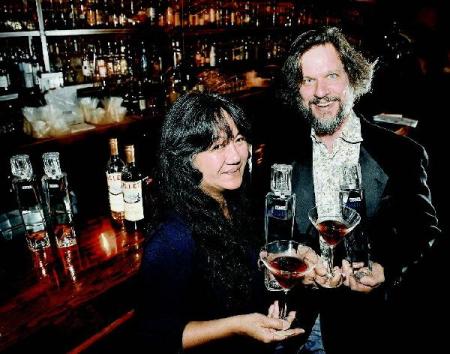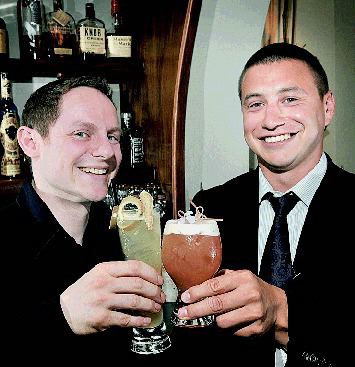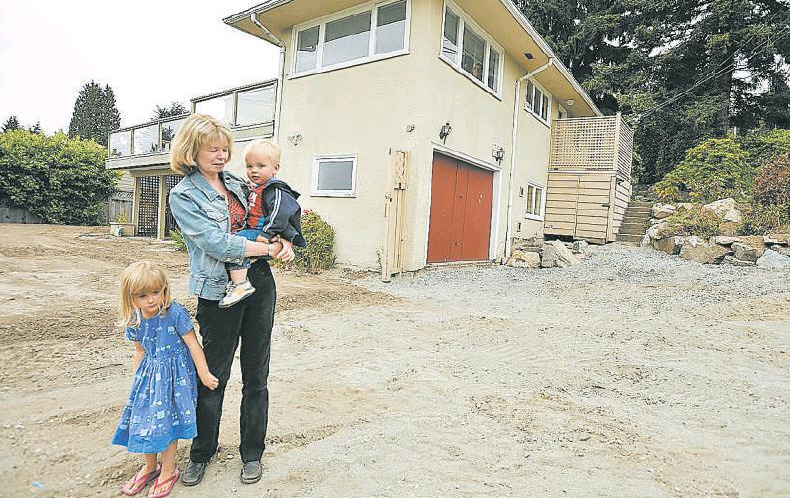Vancouver’s extra-special cocktail
Joanne Sasvari
Sun

Cocktail historians Anistatia Miller (left) and Jared Brown are among many international experts who visited Vancouver’s bars and lounges recently. All praised the city’s cocktails. Photograph by : Mark Van Manen, Vancouver Sun

Vancouver bartenders Brian Grant (left) of Yew’s and Josh Pape of Chambar’s placed fourth and second, respectively, at this year’s Giffard Liquers international cocktail contest in France. Grant mixed a Pacifica Cocktail while Pape whipped up his Le The de Demon specialty. The competition included bartenders from France, Germany, England, Sweden and Poland. Photograph by : Ian Lindsay, Vancouver Sun
Take a measure of style and an equal portion of substance. Add a pinch of history, a splash of creativity and a generous dash of hospitality. Shake it all up and serve with a garnish of something deliciously frivolous.
That’s how you make a great cocktail.
It’s also a pretty good recipe for a great cocktail city. And if it sounds an awful lot like this city, that’s because Vancouver is quickly becoming one of the world’s best places to get a decent drink.
“If you add up the number of bars here doing great, original, classic creations that are what you could call artisanal cocktails, there are probably more bars doing it here than there are in Manhattan,” says cocktail historian Jared Brown.
“This city has more passion about cocktails and it’s had it longer than most places in North America,” adds Anistatia Miller, his partner in both life and work.
Miller and Brown are just two of the many international cocktail experts to hit town recently, eager to check out the scene. They’ve come to teach techniques, share recipes, scout out talent and, above all, enjoy a cocktail or two.
“We were all really, really impressed by the cocktails we had here,” says Miranda Dickson, the U.K.-based head of brand education for Wyborowa Vodka. “It was one of the most exciting cities we’ve visited, in terms of a cocktail experience.”
“It was so evident that on every menu there were some serious drinks, and not just in the obvious places,” says her colleague, master mixologist Dre Masso.
Dickson and Masso visited Vancouver in March and returned this month to host a two-day seminar and competition called the International Cocktail Experience, which fea
tured presentations by Brown and Miller.
They’ve done these seminars in cities all over the world, including Toronto and Montreal, and what they found in Vancouver simply blew them away.
“It was such a stark contrast to Montreal, you wouldn’t even have known you were in the same country,” Dickson says.
But ICE isn’t the only major cocktail event that’s been held here in the past year.
Last fall, Bruno Giffard, head of the family-owned Giffard Liqueurs, visited town to host a competition looking for bartenders to participate in his company’s international cocktail contest, held each May in France.
And why not? After all, in 2007, a Vancouverite, Chris Brown of Beyond Restaurant and Lounge, surprised the Europeans by apparently coming out of nowhere to win the whole thing.
This year, Chambar’s Josh Pape placed second and Yew’s Brian Grant came in fourth, proving that our bartenders can hold their own against the best from France, Germany, England, Sweden and Poland.
“There’s a really serious core of cocktail bartenders in Vancouver who can compete with anyone, anywhere in the world,” Pape says.
There have been numerous other competitions in the past year, hosted by companies such as Grey Goose, Effen and Grand Marnier. And each time, the international reps remark on the quality, creativity and knowledge they’ve seen.
In fact, what our bartenders are doing is creating what celebrity mixologist Tony Abou-Ganim calls “destination cocktails.”
“How many places can you walk up to the bar and be guaranteed you’re going to have a great bartender experience?” asks Abou-Ganim, who was here in March, with fellow international bartending superstar Dale DeGroff, to lead the Finlandia Finnishing School for local bartenders.
“Would you go out of your way for that experience? Absolutely.”
And if the world’s bartending community is going out of its way to taste Vancouver‘s cocktails, the rest of the world can’t be far behind.
Although today’s craze for handcrafted cocktails is only a few years old, the city’s love affair with the cocktail blossomed in the 1950s, when the first cocktail lounge opened at the Sylvia Hotel. It came into full flower in the late ’80s at the original Delilah’s in the Buchan Hotel.
It was there that a bartender known only as Lola introduced the city’s first 60-cocktail list, which featured modern martinis with cheeky names like the Friend of Dorothy (Stolichnaya vodka, Midori melon liqueur and Rose’s Lime Cordial) or Martini Navratilova (Stoli and Gatorade).
“This city was the first in North America to start writing those deep cocktail menus,” says Brown, who believes Delilah’s may have started the continent-wide mega-martini trend of the ’90s.
He and Miller discovered Delilah’s in 1994 when they moved to Vancouver from the United States. They have since moved on to London and spend much of their time overseeing a spirits museum in the South of France. But they lived here for three years, and they credit this city with inspiring them to make cocktails their career.
It wasn’t just the ‘tinis at Delilah’s — or, later, at Lola’s own joint, Lola’s at Century House — that they loved.
“A big part of it was the lounge music,” Brown recalls.
It was also the swanky hotel lounges and the retro-funky hangouts like the Waldorf Hotel’s Blue Lizard Lounge and, of course, the tiki bar at Trader Vic’s, where they served fantastical drinks like the Scorpion, a rum-based concoction that arrived in a giant bowl garnished with a floating gardenia.
“Remember when they tried to close Trader Vic’s?” Miller says with a laugh. “There was this big protest, all these young lounge lizards.”
By now Lola has left to work in Hollywood, Trader Vic’s has long been closed and, even though Delilah’s still serves cleverly named cocktails at its new location, they aren’t, frankly, very good. No matter, because there are plenty of other places that are serving good cocktails.
And not just good cocktails, but epic ones, like Boneta’s bloody mary made with heirloom-tomato gazpacho, housemade Worcestershire sauce and a garnish of quail egg and bacon. Or Chambar’s bellini update made with sparkling wine, peach puree and a basil-peppercorn reduction. Or West’s retro-fabulous original-recipe mai tai with house-made orgeat (almond syrup).
In the best bars, the bartenders are following the city’s culinary trend of using only fresh, local, seasonal ingredients.
“We’re trying to balance drinks the same way a chef makes a dish. That’s how I approach a drink,” Chambar’s Pape says.
It’s not just the flavour and craftsmanship and balance of the drink that matters, but everything else, too.
“What impressed me in Vancouver was the impact when you went into places. Everything was 360 degrees thought out,” says Dickson, who compares Vancouver‘s scene to that of Sydney, Australia.
“The bars look good, they’re designed well, and the drinks are put together well. And it’s not limited to one or two places.”
Beyond that, there is the talent behind the bar. As Brown points out, “a bartender’s job is, first and foremost, to create the type of experience that ensures a customer’s impression is better when he leaves than when he came in.”
One of the great strengths of the scene here is that the bartenders are such a tight-knit community.
“We all kind of work together and bounce ideas off each other,” Pape says. “We don’t really compete with each other.”
So when West’s David Wolowidnyk (who is also the Grey Goose Vodka “arbiter of cool” national pour master champion) and Colin Macdougall won this month’s ICE competition, their colleagues ribbed them with good-humoured resignation.
And when the relatively unknown Brian Grant won the local Giffard competition last fall, a respectful murmur went through the crowd.
“There’s a very adult attitude among the bartenders,” Dickson observes. “They have a genuine appetite for what they are doing.”
Pape says: “We really do have something interesting here that I’m really proud to be part of.”
It’s a sentiment echoed time and again in conversations with the city’s best bartenders, from Ron Oliver at Bluewater to Mark Brand at Boneta to Nick Devine at the Cascade Room to Jay Jones just about everywhere.
Dickson, the been-everywhere, seen-everything cocktail expert who’s been tasting drinks around the world for the last three years, sums it up best. She says, “We were like, ‘Oh, my God, we love Vancouver.’ “
—
10 Great Cocktail Lounges
Vancouver has no shortage of places to try handcrafted, artisanal and classic cocktails. Here are 10 of the best:
– Anywhere cocktail consultant and mixologist extraordinaire Jay Jones is shaking a drink, training the staff or designing the cocktail list, including the Granville Room (957 Granville St., 604-633-0056), Fuel (1944 W. Fourth Ave., 604-288-7905, Fuelrestaurant.ca), and Donnelly Nightclubs (Dhmbars.ca).
– Bluewater Cafe, 1095 Hamilton St., 688-8078, Bluewatercafe.net
– Boneta, 1 West Cordova St., 604-684-1844, Boneta.ca
– Cascade Room, 2616 Main St., 604-709-8650, Thecascade.ca
– Chambar, 562 Beatty St., 604-879-8650, Chambar.com
– Chow Restaurant, 3121 Granville St., 604-608-2469, Chow-restaurant.com
– George Ultra Lounge, 1137 Hamilton St., 604-628-5555, Georgelounge.com
– Ocean Club, 105 – 100 Park Royal, West Vancouver, 604-926-2326, Theoceanclub.ca / Mountain Club, 40 – 4314 Main St., Whistler, 604-932-6009, Themountainclub.ca
– West, 2881 Granville St., 604-738-8938, Westrestaurant.com
– Yew Restaurant + Lounge, Four Seasons Hotel, 791 West Georgia, 604-689-9333, Fourseasons.com
© The Vancouver Sun 2008








